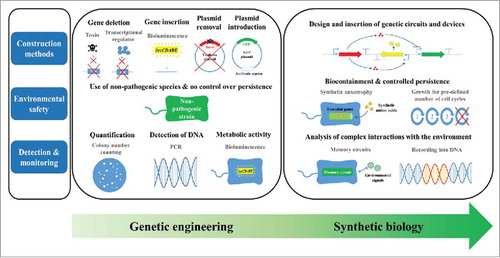Figures & data
Table 1. Comparison between field-use surrogates of food-borne pathogens and B. anthracis.
Figure 1. Current status and future prospects of research for field-use surrogates. Current surrogate construction primarily depends on simple deletion (removal) and insertion, while design and insertion of genetic circuits and devices in synthetic biology would potentially expand utility of surrogates in the future. Concerns regarding environmental release of genetically engineered microorganisms can be overcome by biocontainment strategies of synthetic biology, whereas current surrogate research has solely relied on natural decay of non-pathogenic microorganisms after release. In the coming years, synthetic biology would enable analysis of more complex interactions between the surrogates and environment beyond those currently studied through rather simple analyses, such as counting the number of colonies, PCR-based DNA detection, and measuring bioluminescence.

